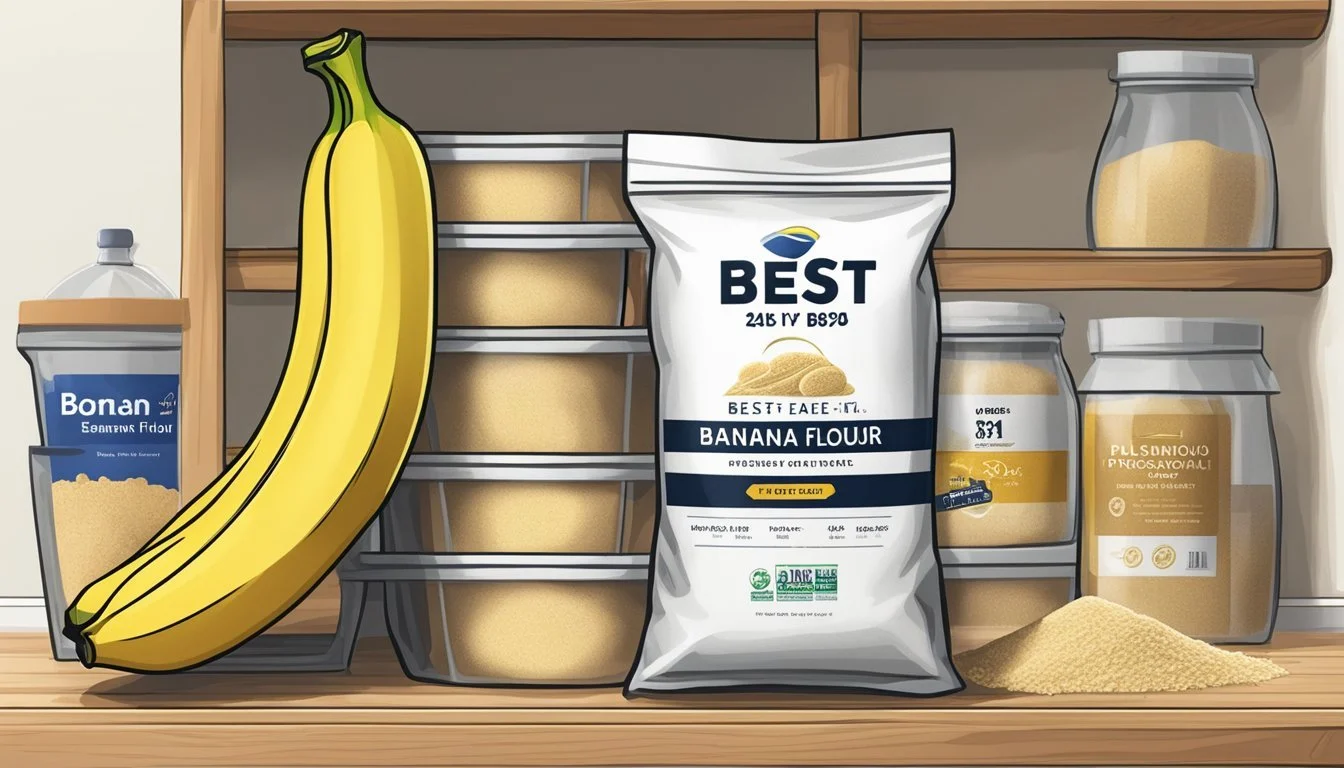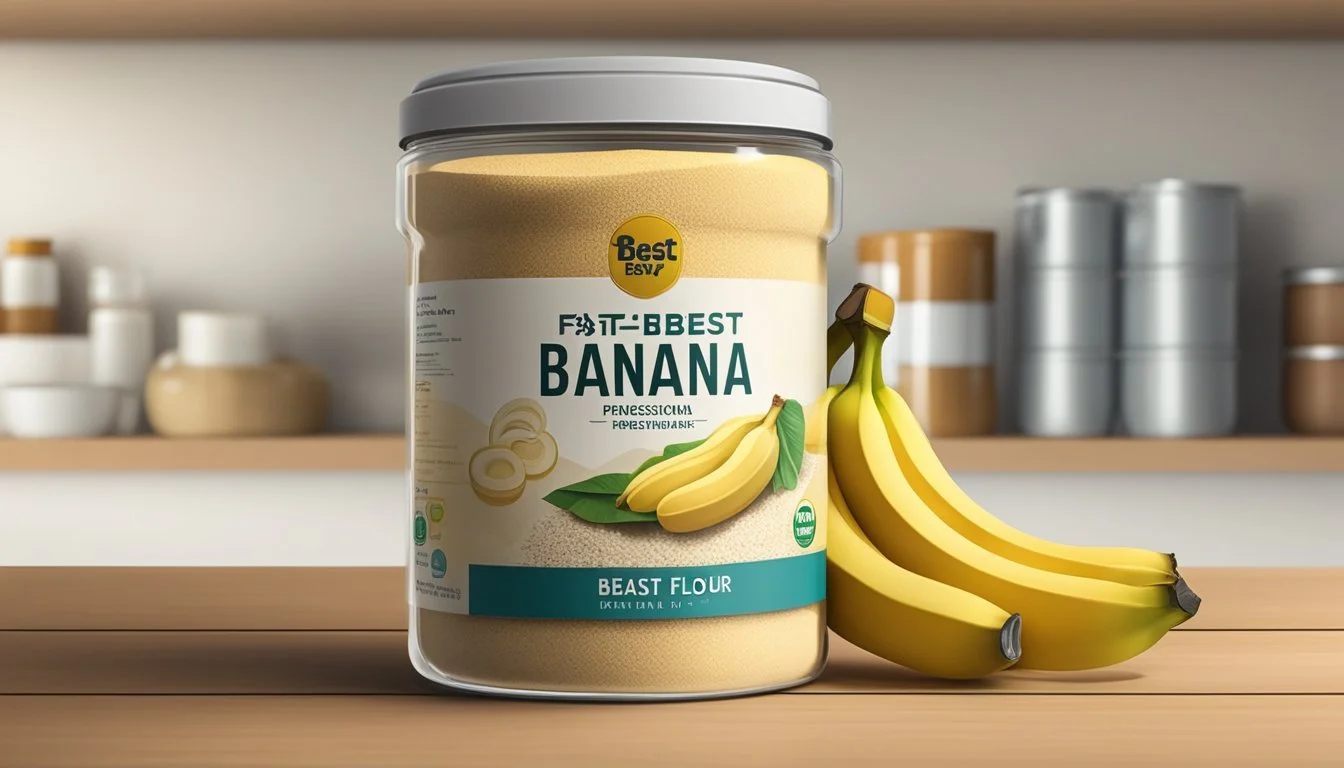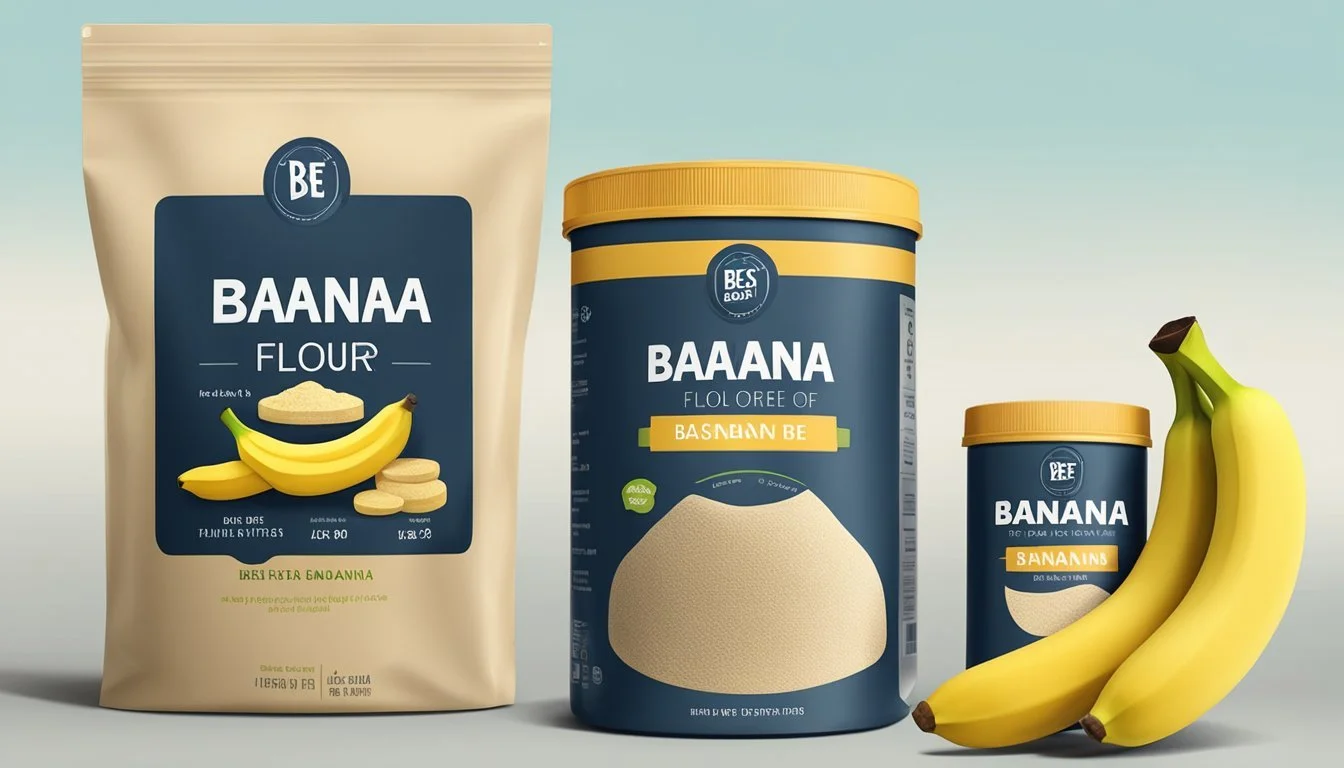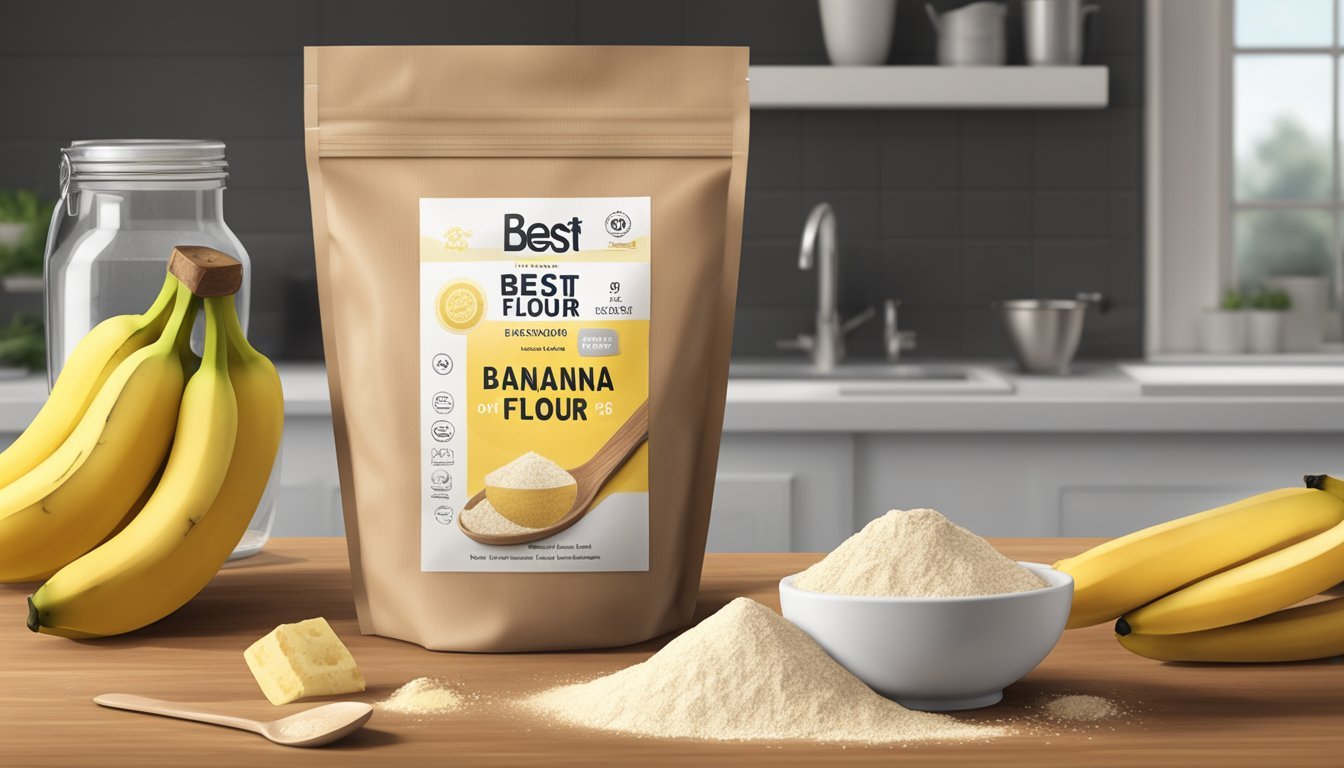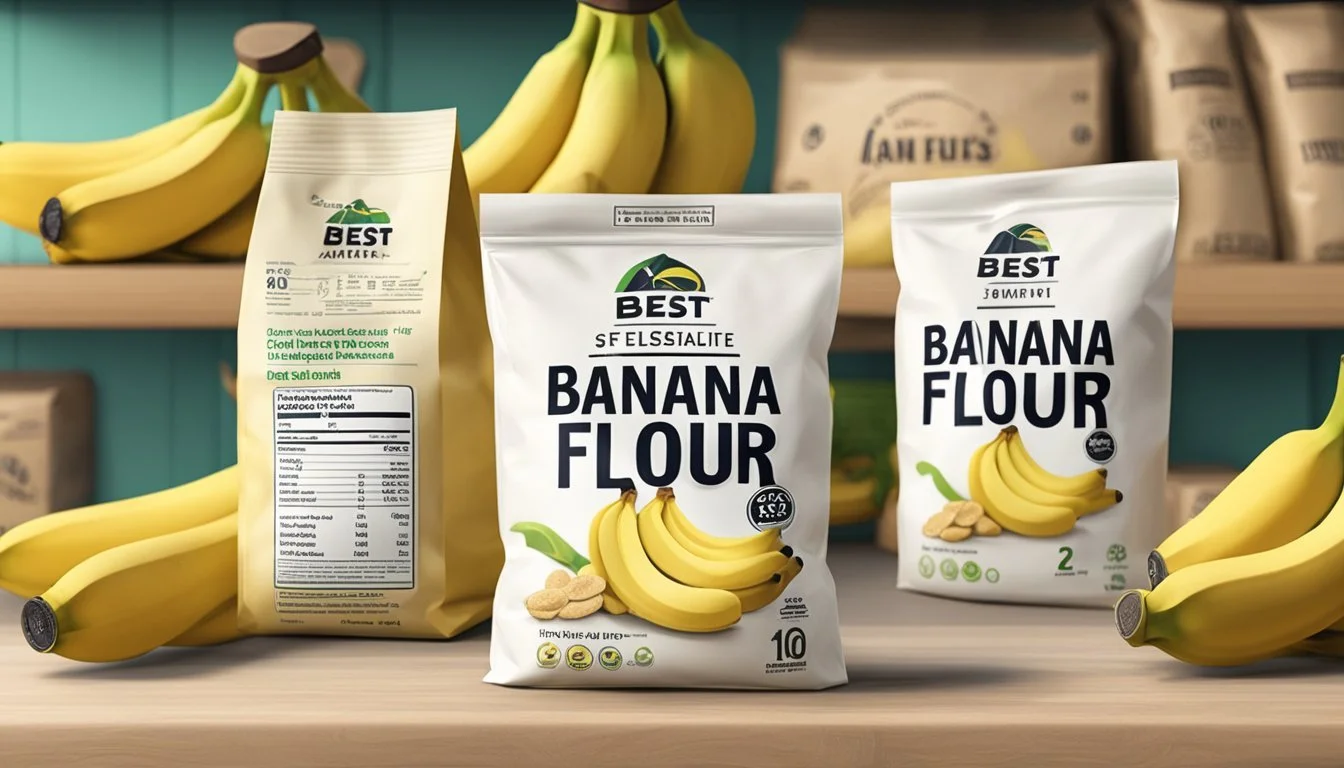How Long Does Banana Flour Last?
Shelf Life and Storage Tips
Banana flour, a gluten-free alternative to traditional wheat flours, is made from green, unripe bananas (how long do bananas last?). Due to its high starch content, it has become popular among those looking for grain-free baking options or following paleo and gluten-free diets. The shelf life of banana flour is a point of consideration for consumers wishing to maintain its freshness and nutritional quality.
Sealed banana flour typically retains its best quality for 1 to 2 years when stored in a pantry. When opened, its shelf life shortens and it's recommended to use it within 6 to 12 months to ensure its freshness. Proper storage is key for maintaining its quality. Storing banana flour in an airtight container in a cool, dry place or refrigerating it extends its usability.
Understanding Banana Flour
Banana flour is recognized for its unique nutritional benefits and gluten-free properties, often derived from green bananas. It's a versatile ingredient that's gaining popularity among various dietary preferences.
Origins and Production
Banana flour is a type of flour made by peeling, drying, and grinding green bananas. This process preserves the bananas’ resistant starch content, which is beneficial for digestive health. Unlike traditional wheat flour, banana flour is gluten-free and thus suitable for those with celiac disease or gluten intolerance. It's primarily produced in regions where bananas are abundant and plays a key role as a sustainable option, preventing waste of overproduced bananas.
Comparison to Other Flours
Compared to all-purpose flour, banana flour is denser in fiber and nutrients. It is a rich source of potassium and provides a good amount of vitamins and minerals. Being grain-free, it's an excellent alternative for keto diets and is popular among gluten-free and health-conscious consumers due to its healthy profile. In terms of baking, banana flour can absorb more liquid than wheat flour, requiring adjustments in recipes. Here's a quick comparison to highlight its distinctions:
Gluten content: Banana flour is naturally gluten-free, whereas wheat flour contains gluten.
Nutritional value: Banana flour surpasses wheat flour in fiber, potassium, and resistant starch.
Taste profile: While almond flour may impart a nutty flavor, banana flour has a mild taste and does not taste like ripe bananas, permitting more versatility.
Uses in recipes: It's commonly used in a 3:4 ratio as a substitute for wheat flour to make baked goods and other recipes grain-free and gluten-free.
Nutritional Profile
Banana flour, derived from unripe bananas, is rich in various nutrients that contribute to a healthy diet. It is an excellent source of resistant starch, which functions as a form of insoluble dietary fiber. This type of fiber supports gut health by promoting the growth of beneficial bacteria in the digestive tract.
Nutrient Composition:
Carbohydrates: Primarily comprised of resistant starch, contributing to lower glycemic impact.
Fiber: High in dietary fiber, beneficial for digestion and satiety.
Protein: Contains a moderate amount of plant-based protein.
Vitamins and Minerals: A good source of essential vitamins such as vitamin C and minerals, notably potassium which is vital for maintaining proper heart function and fluid balance.
A table summarizing the nutritional value per serving:
Nutrient Amount per Serving Calories 100 kcal Carbohydrates - Dietary Fiber - Protein - Potassium - Vitamin C -
Note: The specific values would depend on the serving size and the brand of banana flour.
Banana flour's nutritional profile makes it a healthy alternative to traditional wheat flour, particularly for those seeking to reduce refined carbs in their diet. Its high fiber content is not only favorable for gut health but can also contribute to a feeling of fullness, which might aid in weight management. Additionally, it is naturally gluten-free, making it a viable option for individuals with gluten sensitivities or celiac disease.
Shelf Life Fundamentals
Banana flour, a gluten-free alternative made from ripe bananas, has a variable shelf life that hinges on storage conditions and exposure to elements that can accelerate spoilage.
Factors Affecting Freshness
Storage Environment: Banana flour’s freshness is greatly influenced by where and how it is stored. An airtight container is essential to prolonging its shelf life, as it minimizes exposure to moisture and air which can lead to a degradation in quality. Keeping the flour in a cool, dry place—away from direct sunlight and heat—helps preserve its texture and nutrients.
Temperature: Cooler temperatures are preferable. Refrigeration can extend the flour’s shelf life to 1-2 years.
Moisture: A low-moisture environment is critical to prevent mold growth.
Light: Exposure to light can degrade the nutrients in banana flour and should be avoided.
Signs of Spoilage
Visual and olfactory cues are the primary indicators that banana flour has gone bad. If the flour develops a moldy appearance or a rancid smell, it should not be consumed as these are clear signs of spoilage and could lead to food poisoning.
Smell: A sharp, off, or rancid odor is a red flag.
Texture: Banana flour should maintain a powdery consistency. Clumping suggests moisture ingress.
Mold: Any visible mold or discoloration means the flour is no longer safe to use.
Quality: Spoilage compromises both the taste and the nutritional value of the flour.
Consumers need to pay attention to these factors and signs to ensure they use banana flour while it’s still fresh and safe, thereby enjoying its full flavor and nutritional benefits.
Proper Storage Solutions
Proper storage of banana flour is crucial for maintaining its quality and ensuring a longer shelf life. Specific storage methods can prevent spoilage and keep the flour in a usable condition for baking and cooking needs.
At Room Temperature
Banana flour should be stored in a cool, dry place such as a pantry. Sealed banana flour can remain stable for 1-2 years when kept in these conditions. Once opened, the shelf life decreases, and it is best used within 6-12 months to maintain optimal freshness.
Refrigeration and Freezing
For extended storage, placing banana flour in an airtight container and storing it in the refrigerator can keep it good for approximately 1-2 years. Freezing is also a viable option; sealed banana flour lasts up to 2 years, and opened flour can be used for 2-3 years if stored properly in the freezer.
Protecting Against Moisture and Air Exposure
To safeguard banana flour from moisture and air, it's essential to store it in an air-tight container. Whether in the pantry, fridge, or freezer, this keeps the flour dry and prevents the intrusion of odors. One can also use plastic wrap or aluminum foil to add an extra layer of protection before placing the flour in a container.
Usage in Baking and Cooking
When incorporating banana flour into baking and cooking, understanding its behavioral properties in recipes is crucial. Its unique qualities offer versatility but may require adjustments in standard baking recipes.
Adapting Recipes
For baked goods like banana bread, banana flour can replace regular flour. Due to its high starch content, banana flour is an excellent thickening agent for sauces and soups. Bakers can typically use 25-30% less banana flour than wheat flour, as it has a higher absorption rate. When making adjustments, they should consider that banana flour does not impart the same sweetness as ripe bananas, so recipe sweeteners might need to be adjusted accordingly. Banana flour does not produce a significant rise on its own, thus for leavened baked goods, a rising agent such as baking powder is essential.
Alternative Uses
Banana flour finds its place beyond traditional baking recipes. In the oven, it works well for creating unique textures in baked goods. Additionally, its mild taste and health benefits make it suitable for alternative uses such as a thickener in stews or a nutritional addition to smoothies. It is also well suited for gluten-free and grain-free cooking, making it a strategic alternative for those with specific dietary needs. Because freezing can extend its shelf life, storing some in the freezer is a practical way to have it handy for various cooking applications.
Extending Shelf Life
Proper storage techniques can significantly extend the shelf life of banana flour. By applying freezing techniques and taking measures to avoid spoilage, one can preserve the quality and nutritional value of banana flour for an extended period.
Freezing Techniques
Freezing banana flour can prolong its usability beyond the typical pantry shelf life. Storing it in the freezer requires:
Packing: It should be packed in an airtight container or heavy-duty freezer bag.
Protection: Wrapping the flour in parchment paper or aluminum foil before placing it in the container can provide extra defense against freezer burn.
Avoiding Spoilage
To prevent spoilage and maintain freshness, one must manage two critical factors: moisture and air exposure.
Moisture Control: Store banana flour in a cool, dry place to prevent it from absorbing moisture from the air.
Airtight Storage: Once opened, transferring banana flour to an airtight container is essential to minimize exposure to air and contaminants.
Frequently Asked Questions
This section addresses common inquiries about banana flour, focusing on its potential substitutions and the considerations one should bear in mind for a healthy lifestyle, especially for homemade baking alternatives and dietary preferences.
Banana Flour Substitutions
When a recipe calls for banana flour and one doesn't have it on hand, they can consider several alternatives. All-purpose flour is a common replacement but lacks the nutritional value of banana flour, including its fiber content. For those maintaining a gluten-free diet, coconut or almond flour might be a better fit. It is important for one to note that banana flour is higher in nutrients and may bind differently compared to other flours, so adjustments in recipes may be necessary. Meanwhile, keto dieters often opt for banana flour due to its lower impact on blood sugar levels, making substitutes like wheat flour less suitable.
Gluten-Free Substitutes:
Coconut Flour
Almond Flour
Keto-Friendly Substitutes:
Almond Flour (Note: Adjust liquid ratios as almond flour is more absorbent)
Healthy Lifestyle Considerations
Banana flour is appreciated by nutritionists for its high fiber content and nutritional value, benefiting digestion and helping to regulate blood sugar levels. Generally considered a healthy alternative to traditional flours, its use supports a range of dietary needs. Banana flour is naturally gluten-free and high in nutrients, which makes it a favorable option for people with gluten intolerance or those seeking more nutrient-dense ingredients in their diets. Homemade banana flour can be a fun project for those looking to control the quality of their ingredients, however, the nutritional value of store-bought banana flour tends to be consistent, as the process of making it homemade can be complex.
Nutritional Benefits:
High in Fiber
Gluten-Free
Diet Compatibility:
Keto
Gluten-free diets
Purchase and Expiration
When purchasing banana flour, consumers should pay attention to shelf life and the expiration date indicated on the package. The shelf life of banana flour can vary depending on several factors, including the packaging, storage conditions, and whether the package is opened or unopened.
Unopened Banana Flour:
Best Quality: Use within 6 months from the purchase date.
Maximum Shelf Life: Can last up to 12 months when stored in a cool, dry place.
Opened Banana Flour:
Best Quality: It is advisable to use banana flour within 6 months after opening.
Refrigerated Shelf Life: If stored in an airtight container in the fridge, it may last 1 to 2 years.
Factors Affecting Quality and Safety After Opening:
Airtight Storage: Essential to prevent moisture and contaminants.
Cool, Dry Place: Avoid sunlight and heat to maintain quality.
Refrigeration: Can extend shelf life but is not required for unopened flour.
Note: The expiration date on the package serves as the manufacturer's guaranteed timeframe for the product's optimal quality; however, banana flour could be safe to consume after this date if it has been properly stored and shows no signs of spoilage.
Maintenance and Care Tips
Proper storage is crucial to preserve the texture and quality of banana flour and extend its shelf life. The flour should be kept in a cool, dry place such as a pantry or cupboard, away from direct sunlight and heat. This prevents degradation of the flour's natural properties and maintains its freshness.
Upon opening, transferring the flour to an airtight container is essential to prevent moisture from seeping in, which could lead to clumping and spoilage. The inclusion of an oxygen absorber, if the package contains one, is beneficial when transferring to a new container.
It's recommended to use banana flour gradually; if using smaller quantities, always ensure to seal the container tightly after each use. Here are the storage guidelines to get the most out of your banana flour:
Condition Shelf Life Unopened Package 6-12 months Opened (Pantry) Up to 6 months Opened (Refrigerated) 1-2 years
To maintain the quality longer, one may consider refrigerating the flour in an airtight container. The cooler environment can help to extend the flour's usability up to two years. Lastly, observe the flour before use for signs of spoilage like off-odors or changes in color. By following these tips, one ensures the banana flour retains its desirable qualities for an extended period.
Banana Flour in Special Diets
Banana flour is a versatile ingredient that fits into various special diets and offers multiple health benefits. For those adhering to a gluten-free lifestyle due to celiac disease or gluten sensitivity, banana flour serves as a suitable alternative to wheat flour, allowing individuals to enjoy baked goods without the worry of gluten content.
From a nutritional standpoint, banana flour is high in dietary fiber, which promotes healthy digestion and can aid in the management of blood sugar levels by slowing down the absorption of sugar into the bloodstream. Nutritionists may recommend its inclusion in diets for its potential to reduce inflammation.
The fiber content also aligns with keto dietary requirements by providing low net carbohydrates, which is critical for maintaining a state of ketosis. However, individuals should consult with a nutritionist to determine the suitability of banana flour for their specific keto guidelines, as total carb content can vary.
Additionally, banana flour is healthy due to its mineral content, including potassium and magnesium, which are essential for overall health. The protein content, although not as high as other flour substitutes, still contributes to its nutritional value.
In terms of benefits, incorporating banana flour into one’s diet can support those looking for nutrient-dense, gluten-free options that do not compromise on taste or texture. Its use in a variety of recipes ensures adaptability to different dietary needs without compromising culinary creativity.
Environmental and Economic Aspects
Banana flour is gaining attention as a sustainable food alternative with pronounced environmental and economic benefits. Unlike all-purpose flour, which comes primarily from wheat, banana flour is produced from green bananas, including those that are unsuitable for export due to size or slight imperfections. This utilization contributes to the reduction of food waste, as these bananas would otherwise go unused.
Banana flour's nutritional value serves as a key selling point; it is rich in resistant starch, beneficial for health, and is considered more nutritious than some other flours. Additionally, for those seeking gluten-free alternatives, banana flour provides a versatile and health-conscious choice.
From an economic standpoint, the production of banana flour can offer a cost-effective solution for farmers, especially within regions that heavily produce sweet, ripe bananas but face an oversupply. Instead of discarding overproduced or suboptimal bananas, they can be repurposed into flour. Here are some key points to consider:
Production Efficiency: Converting bananas into flour can be more efficient and cost-effective than relying solely on ripe, sweet bananas for direct consumption.
Market Demand: The rise in popularity of alternative flours has increased market demand, potentially offering new economic opportunities for regions that grow bananas.
In sum, the shift towards banana flour not only presents a promising alternative to traditional baking ingredients, but also affirms a commitment to more environmentally conscious and economically viable food production practices.
Final Thoughts
When considering the shelf life of banana flour, one must understand that proper storage is paramount to ensure longevity. Generally, banana flour can last between 6 to 12 months; however, with optimal conditions, it might be extended up to a couple of years after its manufacturing date.
Key factors to prolong shelf life are:
Avoidance of Sunlight and Heat: Store in a cool, dark place.
Moisture Control: Keep it dry to prevent spoilage.
Airtight Storage: Use containers that seal well, especially after opening.
Banana flour's versatile nature in gluten-free and paleo baking has made it quite popular. Users should take advantage of its extended shelf life by adhering to these storage principles. It's also recommended to observe the product for any signs of spoilage such as off odors or clumps which indicate moisture exposure before use.
By following these guidelines, consumers can make the most of banana flour's utilities without compromising on quality and taste. Remember that the shelf life can significantly vary depending on storage conditions and handling.

